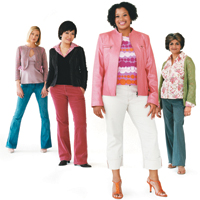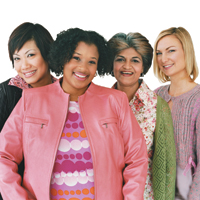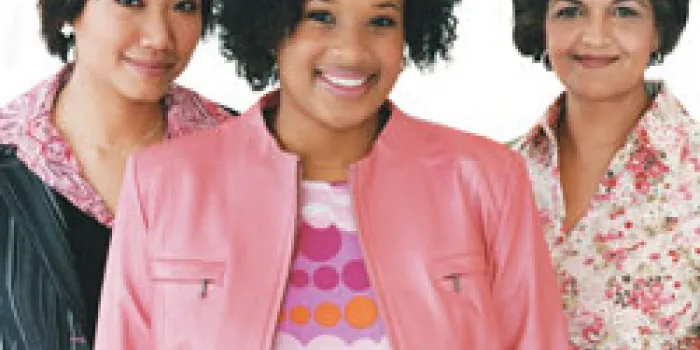When people think of bleeding disorders, they usually think of men and hemophilia. But the truth is, girls and women have bleeding disorders of their own, and they need answers about treatment and complications.
For women in the bleeding disorders community, 1998 was the start of a revolution. That year marks the convening of the National Hemophilia Foundation's (NHF’s) first Women with Bleeding Disorders Task Force. From this beginning came the Project Red Flag awareness and education campaign and other initiatives for women. Celebrating 10 years of improving the quality of women’s lives and health is important. And so is remembering those who made it possible—the women who have been at the forefront of radical change.
[Steps for Living: Bleeding Disorders in Women]
Women looking for answers about bleeding disorders have turned to NHF since it was founded in 1948, first as mothers who were hemophilia carriers or as wives whose husbands had hemophilia. Historically, women have had a difficult time getting their symptoms diagnosed by healthcare providers. In the rare instances when they were adequately diagnosed (often only after an injury or traumatic event), they were told no treatments were available, notes Mary Anne Schall, RN, regional coordinator of the Region V Federal Hemophilia Treatment Centers at the Great Lakes Hemophilia Foundation (GLHF) in Milwaukee. The message women received was that they had to live with such health risks as incapacitating heavy periods and difficult pregnancies and childbirth.
“Women with bleeding disorders were a population with a need, but they were a forgotten element,” Schall says. “Even today, many healthcare providers do not realize women can have bleeding disorders.”
For many women, being forgotten and ignored was unacceptable. Some turned to NHF and its chapters for information. “It was not until NHF began providing resources and information that women began to find the one-on-one support that they needed,” Schall says.
Slowly at first, and then with powerful momentum, women with bleeding disorders found each other and shared their stories. Frustrated with the general ignorance and insensitivity surrounding their bleeding issues, they set out to end their silent suffering.
Schall was one of the authors of the “Woman-to-Woman” manual. It helped train volunteers to go out in the community and teach women about the signs and symptoms of bleeding disorders. This resource, rolled out in 1999 and 2000, was developed by GLHF along with the Hemophilia Foundations of Michigan, Minnesota and the Dakotas, and Illinois. “Woman-to-Woman” connects undiagnosed women with hemophilia treatment centers (HTCs) and chapter services. It is a major component of the Project Red Flag education program and was updated in 2005. Women with bleeding disorders who have finally received a definitive diagnosis are working to identify other women so they will not have to wait the CDC-reported average 16 years it has typically taken to get a diagnosis.
Providers get on Board
Stephanie Seremetis, MD, a former director of the HTC at the Mount Sinai Medical Center in New York City, and currently global medical director in hemostasis for Novo Nordisk A/S in Denmark, says hematologists began asking each other, “What were we as a specialty missing? And what were the generalists missing?” The answers, perhaps obvious now, were von Willebrand disease and platelet function disorders.
Jeanne Lusher, MD, director of the Hemophilia, Hemostasis and Thrombosis Program at Children’s Hospital of Michigan in Detroit, recalls seeing patients who bled so heavily that they did not want to leave their homes during their menstrual cycles. Yet these women didn’t know their symptoms were abnormal. When Lusher discovered such a patient had an underlying bleeding disorder causing her heavy periods, she would question other family members and often found that they had it, too.
“Most of these young ladies turned out to have VWD,” says Lusher, who also served on the first NHF Women’s Task Force. “There were an awful lot of women out there who did not know why they were having so much bleeding, and just suffering. It became apparent that there was a big unmet need.”
There was some backlash against the women’s task force, Seremetis says. But history has proven the validity of the task force—significant morbidity and mortality have been prevented by focusing attention on diagnosing women’s bleeding disorders.
 Drs. Seremetis and Lusher developed the first healthcare provider slide presentation on women’s bleeding disorders for NHF.
Drs. Seremetis and Lusher developed the first healthcare provider slide presentation on women’s bleeding disorders for NHF.
Moving quickly on the provider front, with the aid of original task force member, Nathan Kase, MD, premier ob/gyn and dean emeritus of the Mount Sinai School of Medicine, NHF met with the American College of Obstetricians and Gynecologists (ACOG) in Washington, DC. This gathering was a milestone both because it was the first time these specialists on the front lines of women’s healthcare had been brought into the conversation about recognizing and caring for bleeding disorders, and because it set in motion two critical actions. First, a vice president of ACOG attended an NHF conference targeting ob/gyns with the messages of recognition and medical management of women’s bleeding disorders. Second, in 2001 ACOG released the Committee Opinion “von Willebrand’s Disease in Gynecologic Practice,” which provided explicit screening recommendations and treatment options.
In 2000, NHF launched Project Red Flag with program partners from the the Centers for Disease Control and Prevention. The national women’s campaign has the aptly phrased tagline, “real talk about women’s bleeding disorders.” CSL Behring (then Centeon) provided an educational grant for this initiative.
NHF’s Project Red Flag, in collaboration with the CDC as a program partner, provided materials, toolkits, training and grants to chapters working with an HTC so they could implement best-practice programs. With these PRF resources, chapters/associations, HTCs and volunteers are identifying and educating women and their healthcare providers.
One Woman’s Legacy
During the early years, it was important for providers to meet some of the women with inherited bleeding disorders who weren’t being diagnosed because they were not the typical consumers served by NHF, says Seremetis.
One of these women was Renée Paper, RN, who had type IIA VWD and hepatitis C. She became perhaps the most influential women’s health advocate in the VWD community, writing and speaking about her own story to educate and empower other women with bleeding disorders.
Originally from California, Paper took a job as an emergency room nurse in Nevada. When she discovered that the state had no comprehensive services for people with bleeding disorders, she created the Hemophilia Foundation of Nevada in 1990 in a spare bedroom of her own home. She then appointed the board of directors, staffed the “office” and secured its first public office space.
Paper died in November 2007 from complications during surgery. She was 49 years old.
“She was fearless and fierce,” says Judith Baker, regional administrative director of the Region IX Federal Hemophilia Treatment Centers at Children’s Hospital of Los Angeles. Paper and Baker were members of the first NHF Women’s Task Force. They were also close friends and colleagues.
Paper was not only a nurse who educated people, but also a consumer, notes Laureen Kelley, president of LA Kelley Communications, Inc., an educational resource for bleeding disorders materials. With Paper, Kelley co-authored the book A Guide to Living with von Willebrand Disease (2006). “She lived the agony of VWD,” Kelley explains. “She had a hysterectomy at a young age and couldn’t have children.” Kelley says Paper was determined to prevent her own experiences from occurring in others.
Paper’s advocacy helped individuals get better care. She also helped bleeding disorders organizations form better strategies for building membership and for collaborating with healthcare providers, Baker says.
After meeting Paper and learning her story, Seremetis and other medical professionals were inspired. “It really helped us to focus to hear from her and others like her,” she says. “She was quite able to convey what it felt like to be a patient struggling with a problem. She was an articulate spokesperson and provider.”
Paper and Baker developed the slide presentation “Anyone Can Have a Bleeding Disorder” for the Project Red Flag toolkit. It continues to be used to raise awareness and identify women with bleeding disorders.
Where Do We Go From Here?
Project Red Flag’s advocacy and education has reached countless women. The program’s unyielding efforts have shifted attitudes and improved understanding of these disorders in the medical community and improved the quality of life for countless girls and women. Among the successes of NHF’s women’s programs, at least one number can be counted—the number of women seen at HTCs. According to the CDC, this number has increased nearly 200% in the past 10 years.
 “Over these 10 years, with our program partner, the CDC, and our funding partner, CSL Behring, NHF has provided approximately half a million dollars in chapter/association grants for women’s outreach and education initiatives,” says Ann-Marie Nazzaro, vice president for education at NHF.
“Over these 10 years, with our program partner, the CDC, and our funding partner, CSL Behring, NHF has provided approximately half a million dollars in chapter/association grants for women’s outreach and education initiatives,” says Ann-Marie Nazzaro, vice president for education at NHF.
“To date, Project Red Flag has awarded eight college scholarships to women with bleeding disorders and carriers,” Nazzaro continues. “Currently, about 75 percent of NHF chapters and independent associations offer women’s programs. The NHF women’s initiative—Project Red Flag—is the catalyst for this success.”
Project Red Flag’s next step is to distribute the first-ever US treatment guidelines on von Willebrand disease from the National Heart, Lung, and Blood Institute, published February 29, 2008. The guidelines cover evaluation, diagnosis and management of VWD. They will be available in two versions: one for providers and one for consumers.
Meanwhile, individual women with bleeding disorders continue doing their part.
Skye Peltier was profiled in Community Alert, NHF’s monthly newsletter (since replaced by eNotes), 10 years ago as an active, athletic 27-year-old with factor VII deficiency. Since then, she has returned to school and earned a physician’s assistant degree in 2005. For the past two years she has been working at the Hemophilia and Thrombosis Center at the University of Minnesota Medical Center in Fairview, where part of her job is to help develop programs for women with bleeding disorders. So far, she has helped oversee two annual women’s educational retreats with the chapter in Minnesota.
“For next year, we’ve talked about including daughters, trying to reach out to the younger group,” Peltier says. “In collaboration with the HTC at Minneapolis Children’s Hospital, we want to create a better tie for young women transferring from pediatrics to adults. If they’ve had issues with menorrhagia as their primary concern, they need to be addressed.”
Peltier says her own health has been good. She had an endometrial ablation (a procedure to destroy the uterine lining) in 2001 to control her menorrhagia. At the end of May, Peltier will complete an 18-month ribavirin interferon treatment regimen to treat her hepatitis C.
As a provider, Peltier says, she has been able to share her own experience as a patient, when appropriate.
Looking Back, Looking Ahead
As a 54-year-old with VWD and the mother of two daughters similarly affected, Jill Williams of Evansville, Indiana, says it gives her comfort to know that young women are more likely today to encounter organized events for women who have a bleeding disorder.
Schall, of GLHF, says girls are getting diagnosed appropriately earlier. Many pediatric treatment centers now connect with adolescent medicine clinics. If a young girl with a heavy period visits an adolescent medicine clinic, she is often referred right away for a hematology checkup.
Still, personal connections are the glue and the fuel that keep so many women going, says Williams. In 1990 she became the first woman with a bleeding disorder to serve on the national board of NHF.
Despite being a busy, full-time teaching student, 25-year-old Betsy Weins, of Franklin, Wisconsin, volunteers on the NHF Women’s Task Force and locally for GLHF. She first got involved in this movement when she wrote to NHF for information about her platelet function disorder and VWD. Weins didn’t understand all the literature, so when she called NHF to ask questions, she ended up volunteering for one of its On the Road education meetings.
Weins learned so much that she wanted to continue. She and her sister completed the “Woman-to-Woman” training and became advocates. Weins lauds the meetings created through Project Red Flag and finds the women involved “incredible.”
“The ideas they come up with are accessible—things we can actually do, and it makes me wish I could go out there and do more,” Weins says. “It’s a great program, and there’s a lot to look forward to. It just keeps on getting better and better.”
Through the continuing work of Project Red Flag and other initiatives, NHF and its chapters and affiliates will continue to empower women and meet their needs. Ideally, the cooperative efforts of the people involved in these education and awareness campaigns will one day assure that all girls and women are diagnosed early and will receive proper treatment and find a network of caring women.

